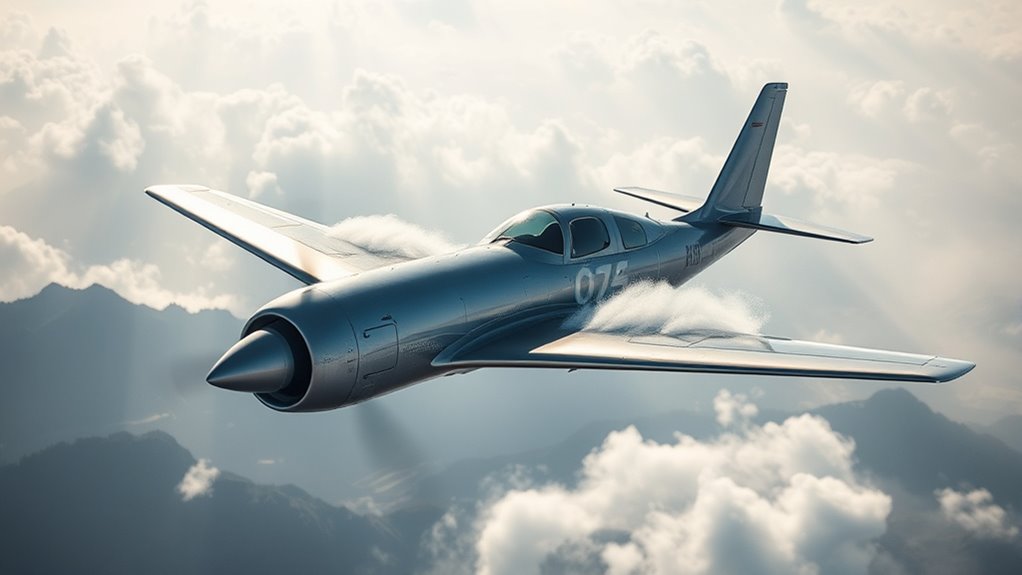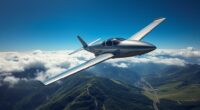Soaring in high humidity affects your aircraft’s performance by lowering air density, which reduces lift and engine thrust. You’ll notice it’s harder to gain altitude, and takeoff distances might be longer. Your engine works harder, decreasing fuel efficiency. Handling could feel different, especially at lower speeds. To maintain safety and peak performance, understanding these effects and adjusting your flight parameters is essential. Keep exploring to learn how to best manage these conditions.
Key Takeaways
- High humidity decreases air density, reducing lift and requiring higher airspeeds for safe soaring.
- Less dense moist air diminishes engine performance, impacting power during initial climb and takeoff phases.
- Reduced lift at the same altitude means pilots may need to increase speed or adjust flight plans.
- Increased fuel consumption occurs as engines work harder to compensate for lower air density.
- Accurate performance calculations considering humidity are essential for safe soaring and effective flight planning.

High humidity levels can considerably impact aircraft performance, especially during takeoff and flight. When the air is saturated with moisture, it affects the way engines operate and how efficiently an aircraft can generate lift. The humidity impact is particularly noticeable because moist air is less dense than dry air, which can lead to reduced engine efficiency and altered aerodynamic behavior. As you prepare for takeoff, you might notice that engines don’t produce as much thrust as they would in lower humidity conditions, requiring longer runways and more power to achieve the necessary speed for lift-off.
This decrease in engine efficiency occurs because high humidity causes a reduction in air density, meaning there’s less oxygen available for combustion within the engine. When engines don’t receive enough oxygen, they can’t generate maximum power, leading to potential performance limitations. You might also observe that during flight, the aircraft’s climb rate diminishes slightly, and fuel consumption can increase as engines work harder to compensate for the decreased efficiency. These factors are vital for flight planning, especially in regions where high humidity prevails, as pilots need to account for longer takeoff distances and possibly adjusted cruising altitudes to maintain ideal performance.
High humidity reduces air density, decreasing engine power and increasing fuel consumption.
Furthermore, the humidity impact extends beyond engines to the aircraft’s lift capabilities. Less dense air means that the wings generate less lift at the same speed, compelling pilots to increase airspeed during takeoff and climb to maintain safe margins. This adjustment can affect flight schedules and fuel planning, as higher speeds often translate into increased fuel burn. Additionally, high humidity can influence the aircraft’s aerodynamic control, sometimes making handling feel slightly different, especially at lower speeds or during critical phases of flight like approach and landing.
Understanding the effects of high humidity on aircraft performance helps you anticipate the challenges it presents. It emphasizes the importance of thorough pre-flight checks and adjustments based on weather conditions. During humid conditions, pilots often rely on performance charts that account for humidity impact, ensuring safety without risking excessive wear on engines or structural components. Recognizing how humidity influences engine efficiency and lift allows you to operate efficiently and safely, even in challenging weather, by adapting your procedures and expectations accordingly. Moreover, awareness of air density changes can assist in optimizing flight parameters and ensuring better overall performance during humid conditions.
Frequently Asked Questions
How Does Humidity Affect Aircraft Engine Maintenance?
High humidity can impact your aircraft engine maintenance by increasing the risk of engine corrosion due to moisture buildup. It also affects fuel efficiency, as humid conditions can lead to water ingression in fuel systems, causing performance issues. You should regularly inspect and maintain the engine components, ensure proper sealing, and use corrosion inhibitors. Staying vigilant helps prevent costly repairs and keeps your engine running smoothly in high humidity environments.
Are Specific Aircraft Models More Affected by High Humidity?
Like delicate dancers, some aircraft models are more affected by high humidity due to their inherent humidity sensitivity. You’ll find that older or specialized aircraft with less advanced corrosion resistance and ventilation systems struggle with humidity’s grip. These models, less adaptable to moisture-laden air, require extra maintenance and caution. Generally, aircraft with advanced materials and modern design exhibit better aircraft adaptability, making them more resilient in humid conditions.
What Are the Safety Protocols During High Humidity Conditions?
During high humidity conditions, you should prioritize humidity monitoring to assess risks accurately. Follow strict safety protocols, including thorough safety training, to stay prepared for potential performance changes. Always check weather updates, communicate with your team, and adjust your flying techniques as needed. Staying vigilant about humidity levels helps guarantee your safety and maintains aircraft performance, preventing emergencies caused by unexpected humidity-related issues.
How Does Humidity Influence Aircraft De-Icing Procedures?
Humidity effects critically influence aircraft de-icing procedures. Higher humidity levels increase the likelihood of ice formation, making de-icing less efficient and requiring more thorough or frequent application of de-icing fluids. You should monitor humidity closely and anticipate longer de-icing times, especially in very humid conditions. Proper de-icing ensures safe flight by preventing ice buildup, which can impair aerodynamic performance and aircraft control.
Can High Humidity Impact Aircraft Navigation Systems?
High humidity hampers your aircraft’s navigation, causing vital errors and sensor malfunctions. Moisture can infiltrate sensitive systems, leading to misreadings or delays in data. You might encounter increased navigation errors, risking route revisions or rerouting. To stay safe, you need to monitor humidity levels closely and rely on backup navigation methods, because high humidity can compromise your aircraft’s navigational accuracy and overall operational safety.
Conclusion
Remember, every cloud has a silver lining, and high humidity isn’t all bad. It can reduce aircraft lift and performance, but understanding these effects helps you adapt and maintain safety. By staying informed and prepared, you can navigate humid conditions confidently. Just like the saying goes, “Forewarned is forearmed,” so keep learning about humidity’s impact on flight. This way, you’ll be better equipped to handle the skies, no matter the weather.









